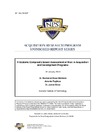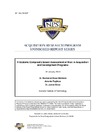Risk Quantification of Acquisition Programs Through Systems Complexity Measures
| dc.contributor.author | Nilchiani, Roshanak Rose | |
| dc.contributor.author | Pugliese, Antonio | |
| dc.contributor.other | Acquisition Research Program | |
| dc.date | 10/21/21 | |
| dc.date.accessioned | 2022-08-04T23:58:38Z | |
| dc.date.available | 2022-08-04T23:58:38Z | |
| dc.date.issued | 2021-10 | |
| dc.identifier.uri | https://hdl.handle.net/10945/70209 | |
| dc.description | Acquisition Research Program Sponsored Report Series | en_US |
| dc.description | Sponsored Acquisition Research & Technical Reports | en_US |
| dc.description.abstract | The objective of this research is to mathematically formulate and manage the relationship between the quantitative complexity level of an acquisition or engineering development program and its relationship to the increased technical and programmatic risk, respectively. This research builds upon the PIs previous research experience and grants (NPS BAA 14-002, NPS BAA 15-001, NPS FOA 16001). This research aims to discover and determine the relationship between the quantitative complexity value of an acquisition program (at various points in its lifecycle) as a measure of increased actual technical and programmatic risk respectively. The main goal is to improve the current inaccurate subjective practice of assessment of risk in different stages of a wide range of engineered system development programs as well as acquisition programs. Currently lifecycle risk assessment methodologies such as color-coded risk matrix are heavily subjective in their nature and therefore weak in the assessment of the actual risk. As a result, acquisition programs frequently are exposed to unforeseen technical and programmatic risks and failures; cost and schedule overruns that are due to inaccurate risk identification and assessments. This research proposal focuses on expanding and examining the novel set of new complexity measures that are recently created by our team (with the PIs previous NPS research grants) as pre-indicators of emergence of risks at different stages of a systems development process and lifecycle. The detailed set of created complexity measures, will be modified and categorized based on their application category in physical/hardware/software systems as well as DoD System of Systems level studies. The refinement and categorization of the complexity/risk measures will be applied to and examine several historical case studies of engineered systems success or failures. The focus of this part of research will be on discovering the suitability of each of the 12 complexity/risk measures for application to the right type and category of subsystem/system/SoS of acquisition programs or complex engineered systems. The focus of the case studies chosen will be at refinement and choice of complexity/risk metric to appropriately fit a particular complex engineered system to various manifestation of increased (or decreased) technical as well as some programmatic risks. Multiple historical and theoretical cases of design of complex engineered systems will be studied. The results of this research project will have a broad public purpose in systems development community in various domains of engineering by improving the quantitative assessment of risk from the preliminary and critical design phase, manufacturing and testing, implementation, operation and the retirement of the system. The research result is expected to be applied to a variety of cyber-physical systems as well as DoD systems of Systems (SoS). The complexity-based risk assessment can be applied to various domains of applications such as telecommunication satellite design, regional power infrastructure design and operation, and the next generation of human spaceflight vehicle and many more. The suggested improved methodology can warn the program manager and the other stakeholders on assessing the alternative courses of action at each stage in systems lifecycle as well as reduction and management of the complexity content to mitigating some of the technical risk that a system is facing. | en_US |
| dc.publisher | Monterey, California. Naval Postgraduate School | en_US |
| dc.rights | This publication is a work of the U.S. Government as defined in Title 17, United States Code, Section 101. Copyright protection is not available for this work in the United States. | en_US |
| dc.title | Risk Quantification of Acquisition Programs Through Systems Complexity Measures | en_US |
| dc.type | Report | en_US |
| dc.contributor.corporate | Naval Postgraduate School (U.S.) | |
| dc.identifier.npsreport | SIT-SE-22-003 | |
| dc.description.distributionstatement | Approved for public release; distribution is unlimited. | en_US |
| dc.description.distributionstatement | Approved for public release; distribution is unlimited. | en_US |





